ARTWORK
They say you should never judge a book by its cover. That's rather a negative saying, carrying the implication that if a book had an attractive cover, you should beware of its contents being "mutton dressed up as lamb". As far as books are concerned though, I hope that's more of the exception, rather than the rule.
The thing is, a good author puts heart and soul into his/her/their writing, and for my part, (whether I'm good, mediocre or poor) I always wanted as much control as possible over the covers within which my books appeared. That's why, with my publisher's permission, I commissioned recognised artists to create my covers for me. I hope you agree it was money well-spent.
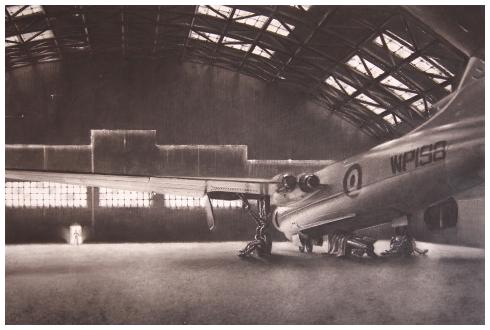 "WP198 at Ndola" - by Jonathan Stockley
"WP198 at Ndola" - by Jonathan Stockley
Jonathan Stockley is both a pictorial artist and an accomplished model-maker, so I got two for the price of one when I asked him whether he could "do" the artwork for Bunkeya.
Julia and I first encountered Jonathan's work at the exhibition of the Royal Society of Marine Artists in 2018. What struck me was that his drawings were executed in charcoal. My mistake, but I had always thought of charcoal as a blunt and brittle medium, yet there was Jonathan displaying a mastery of both fine detail and shading in a drawing called 'Aegir on the Tyne'. What hit me was that if I could persuade him, he would be the ideal artist to re-create the scene from chapter 7 of Bunkeya in which the crew of the stricken Vickers Valiant, WP198, collapse with fatigue after making safe the weapon that had been damaged in the aircraft's heavy landing.
But what convinced me that I'd got the right artist was when I found out that Jonathan had trawled e-Bay to find a (discontinued) Airfix kit of the Vickers Valiant, made it, painted it AND THEN he made a model of an aircraft hangar out of corrugated cardboard, cut skylight holes in the roof and shone a light through the holes so that he could reproduce the exact sheen on the aircraft's fuselage. Now that's what I call dedication.
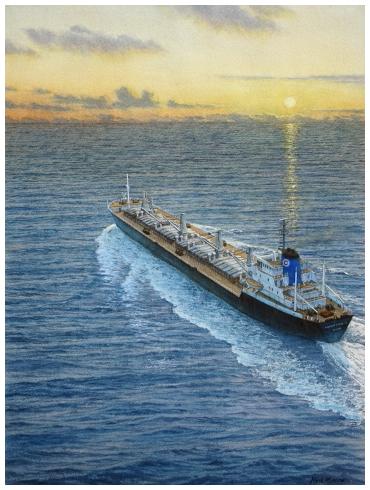 "The Cullinan Cavalier - Mid-Pacific"
"The Cullinan Cavalier - Mid-Pacific"
by Mark Myers
Mark Myers is a past president of the Royal Society of Marine Artists.
Over the years, Julia and I have admired Mark's work more and more. We don't know anyone who can paint water with Mark's understanding of its many moods and colours. The sea, the sky, the ships themselves, Mark Myers is not only an absolute master of marine art, but a good friend. Who better, to portray, for Pedro Miguel, the unsuspecting Cullinan Cavalier, surging along at 14 knots as dawn breaks in the Pacific?
What you can certainly see is that Mark has a great gift.
What you don't see until someone tells you, is that Mark's love of the sea and ships leads to a search for perfection. For instance, Mark has painted a number of Christmas cards for sale via the Royal National Lifeboat Institution - the RNLI. What distinguishes those paintings is that Mark will have spent many hours going through every record that he could get his hands on. If he is painting the story of a lifeboat rescue, for instance, it isn't just a question of what the casualty vessel looked like...
What time of day did the rescue take place? What was the state of the tide?
On other occasions I have known Mark to get hold of Luftwaffe aerial photo-reconnaissance shots of a British battleship just to know where she lay on which berth, and what vessels might (or might not) have been tied up ahead, astern or alongside her.
So there's the painting of the m.v. Cullinan Cavalier, aboard which the long-suffering Indian crew are signed-on for a two-year stint and Danny Rook will be lucky if his relief gets flown out after five months... A bygone way of life for many seafarers, preserved in watercolour by Mark Myers. I hope you admire the painting as much as Julia and I do.
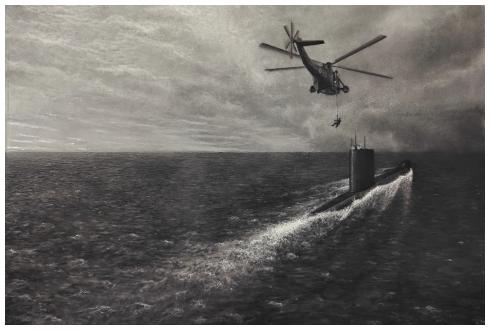 "Next Stop - The Rock" - by Jonathan Stockley
"Next Stop - The Rock" - by Jonathan Stockley
Clearly, after producing such an evocative charcoal drawing for the cover of Bunkeya, Jonathan Stockley was a great choice of artist to create the cover drawing for Kola.
Jonathan and I discussed the sort of image that I felt I needed, before settling on the following scene from chapter nine.
Monday 24 November 1975
"...As he stood on the casing of the submarine, with his back to the fin, he could hear the throb of helicopter rotors, gaining in volume. The sailors tightened his harness and helped him into a life-jacket. It was now half-light. To his left, Danny saw the helicopter coming in with no apparent hesitancy. It executed a tight turn above the wake, then flew along the submarine’s port side, about forty feet above the water, arresting forward motion by raising its nose. The downwash from the rotors flattened the surface of the sea and filled the air with a salty mist. Danny noticed the way that the foam from the submarine’s bow wave was creaming aft on either side, and estimated that the boat was still sailing at over 10 knots..."
Naturally, Jonathan then got to work. He constructed and painted a model of a Royal Navy Sea King helicopter, hung it out of a window to photograph it under a selection of different lighting conditions and from a variety of angles, and then sent me some rough sketches... As for me, all I had to do was wait.
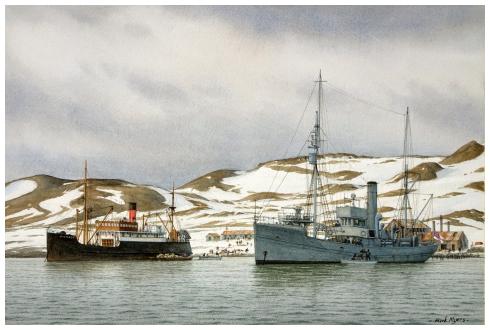 "Operation Tabarin: The William Scoresby and SS Fitzroy in Whalers Bay, Deception Island February 1944"
"Operation Tabarin: The William Scoresby and SS Fitzroy in Whalers Bay, Deception Island February 1944"
- by Mark Myers
The circumstances that eventually brought about the Secret History novel, "Tabarin" are weird and fascinating. When I told Mark about them, both he and I went on a search to know more. My quest, for instance, took me to the headquarters of the British Antarctic Survey outside Cambridge. For his part, Mark researched HMS William Scoresby and delved into the Admiralty charts. The scene that we chose portrayed the arrival at Deception Island of the Royal Naval party that was to conduct "Operation Tabarin".
Thursday 3 February, 1944
Port Foster, Deception Island
Latitude 63° South
"...A covering of snow sugar-iced the ridges that surrounded the bay. Despite the near-freezing air, in various places steam hung in clouds over fumaroles and the whole place stank of sulphur, overlaid with the fishy reek of rotting seabird guano. And this was the place where the Tabarin expedition proposed to establish its first base, paradoxically entitled ‘Base B’. This was where they planned to erect the accommodation, the radio station, the laboratories and the administrative centre, including the magistrate’s courtroom and the post office. This was to be home for five men until they were relieved perhaps a year later when the surrounding waters became relatively clear of ice and it was safe to navigate again..."
The artwork above is one of two paintings that Mark crafted for us. It's beautiful, isn't it?
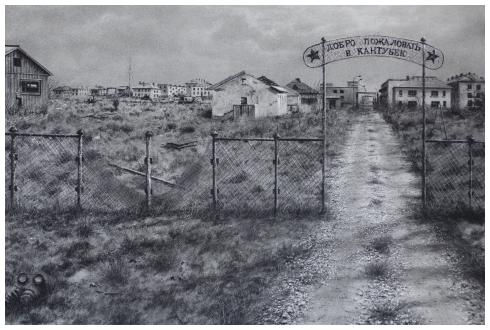 "Welcome to Kantubek" - by Jonathan Stockley
"Welcome to Kantubek" - by Jonathan Stockley
If (by now) you have visited Jonathan Stockley's website, you will have seen that one of his specialities is the portrayal of the industrial wasteland. So, I reasoned, there must be few artists as well qualified as Jonathan to give readers an impression of the utter ghastliness of the abandoned Soviet-era biological warfare factory, Kantubek, crumbling to dust on Vozrozhdeniye island in what was once (before it dried up) the Aral Sea.
The title of Jonathan's drawing - again executed in charcoal - 'Welcome to Kantubek' is also, of course, a translation of what is written in Russian above the entrance portal: ‘ДОБРО ПОЖАЛОВАТЬ В КАНТУБЕК’. (And if you want to be absolutely correct, I believe that "Kantubek" should be pronounced with the emphasis on the third syllable.)
"...a stranded fast patrol boat, sand-blasted to bare and rusted metal, becalmed for ever in drifts of sand at a concrete wharf; a Soviet tank with its trademark shallow-domed turret rusting at a former workshop, the tin structure now stripped of its roof and tools; an abandoned respirator mask, the rubber perished and crumbling; a Red Army lorry, wheels gone, collapsed on its chassis, windscreens broken; a parade square, empty of troops, now starting to break up as grass and weeds squeezed into the spaces between the concrete pads, where moulds and insects had eaten away at the wooden shuttering, exposing the earth beneath and allowing it to erupt to the surface once again..."
Perhaps the horror of the Kantubek site is another reason why I am drawn to writing 'Secret History stories... It's that even though we may see only one percent of the repulsive things that went on, the truth is so much stranger, more gruesome and shameful than fiction that it becomes correspondingly more important that people should know. But equally, there can't honestly be a solution to treaty-breaking until both sides agree to stop trying to find ways to wipe each other out... and then shaking hands and agreeing to comprehensive verification measures.